Strategies for Inclusive Teaching and Lesson Plan Design
VerifiedAdded on 2023/06/14
|24
|6443
|481
Report
AI Summary
This report delves into the crucial aspects of lesson planning, emphasizing the creation of inclusive and effective learning environments. It begins by defining the aims and characteristics of lesson plans, highlighting how they should incorporate learner goals and needs. The report analyzes various learning styles and taxonomies, such as Bloom's Taxonomy and Herzberg's theory of motivation, and explains how to integrate them into lesson designs. It further discusses strategies for ensuring inclusivity in lesson plans, covering factors like location, learning surroundings, and action against discrimination. The report also details the steps to prepare an effective lesson plan, including identifying learning objectives, planning learning activities, and assessing student understanding. It addresses the importance of flexibility and adaptability in lesson design and provides insights into different lesson plan designs for inclusive teaching and learning. Additionally, the report explores how lesson plans can meet individual learner needs, monitor progress, and incorporate feedback. Finally, it defines assessment and evaluation, analyzes different assessment methods, explains the use of differentiated assessment, and discusses how assessment results inform future lesson planning.
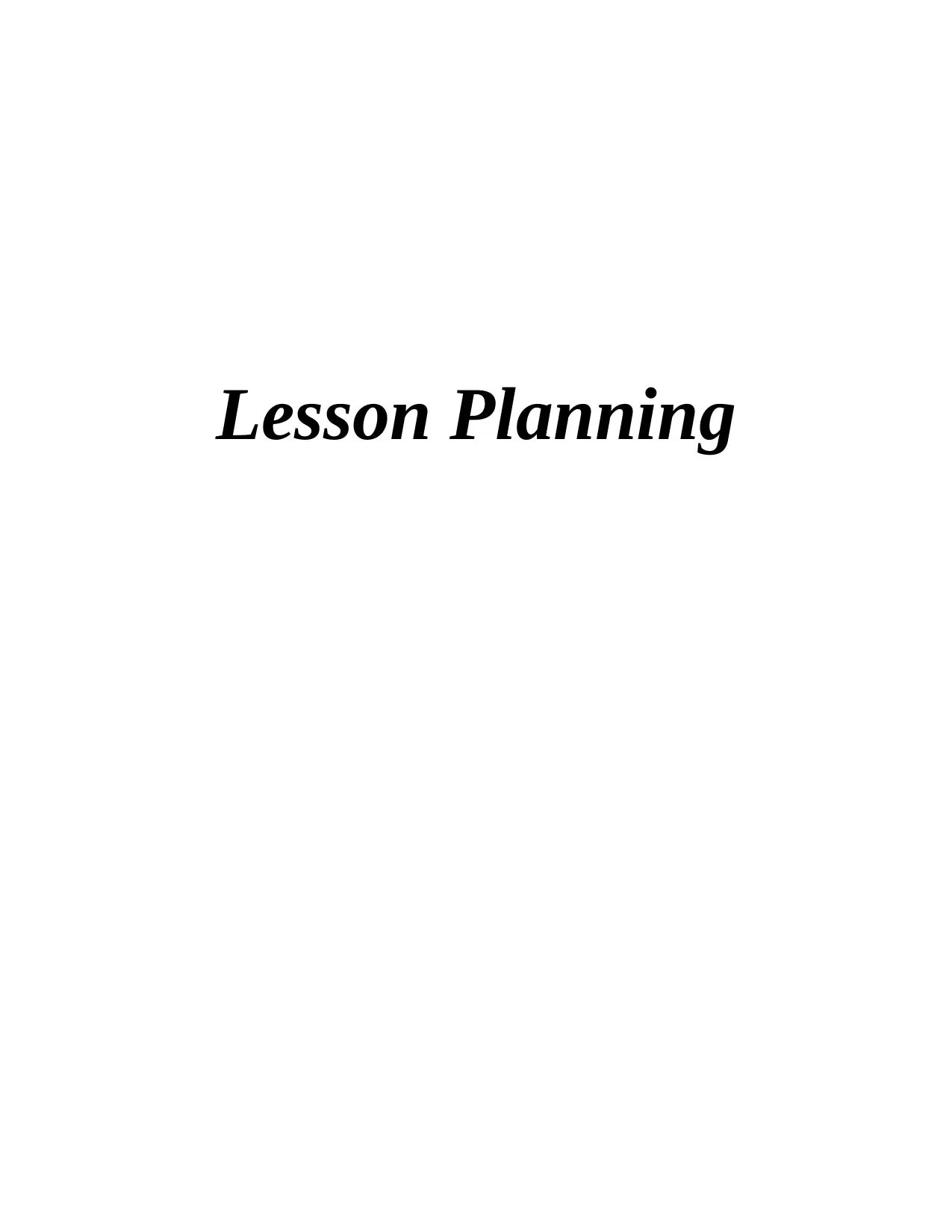
Lesson Planning
Paraphrase This Document
Need a fresh take? Get an instant paraphrase of this document with our AI Paraphraser
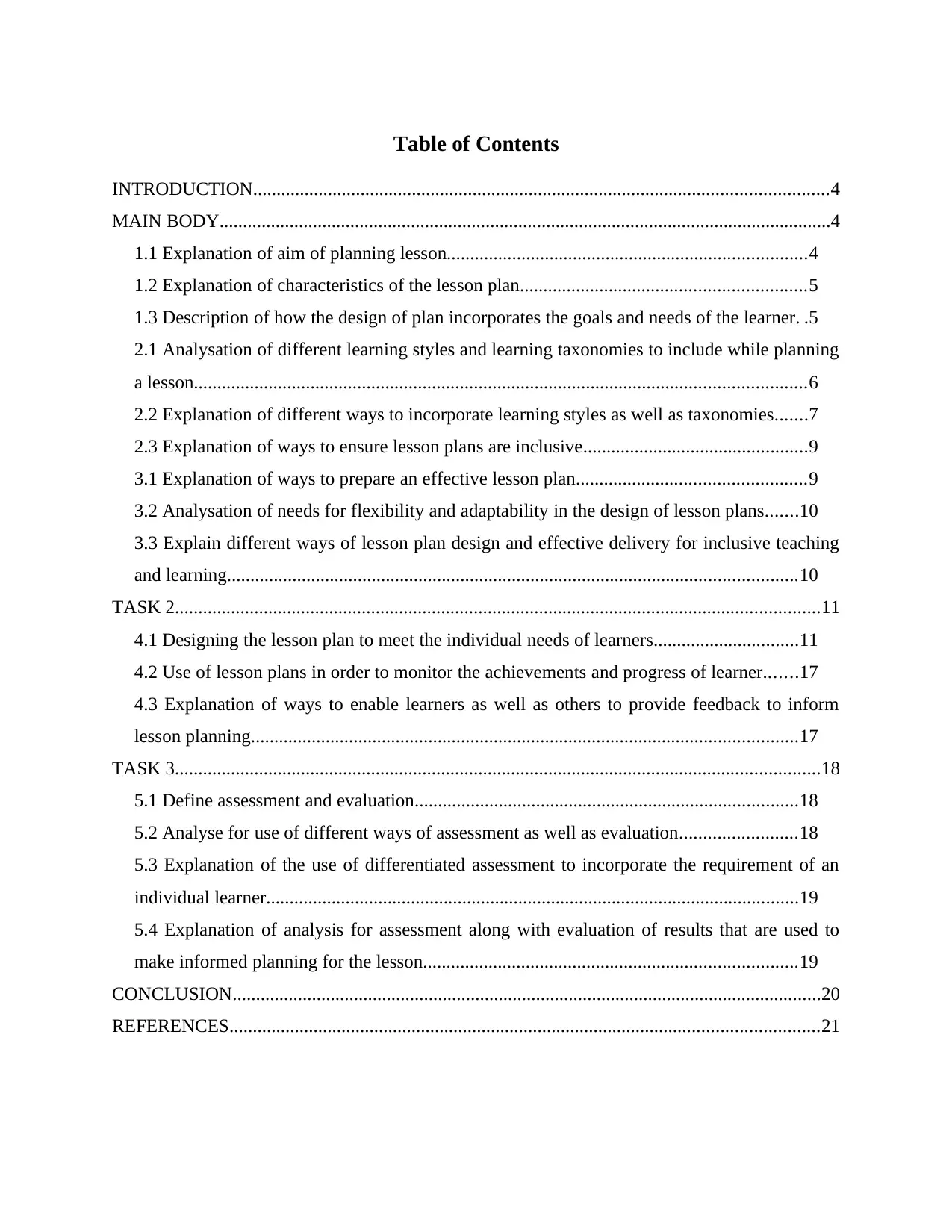
Table of Contents
INTRODUCTION...........................................................................................................................4
MAIN BODY...................................................................................................................................4
1.1 Explanation of aim of planning lesson.............................................................................4
1.2 Explanation of characteristics of the lesson plan.............................................................5
1.3 Description of how the design of plan incorporates the goals and needs of the learner. .5
2.1 Analysation of different learning styles and learning taxonomies to include while planning
a lesson...................................................................................................................................6
2.2 Explanation of different ways to incorporate learning styles as well as taxonomies.......7
2.3 Explanation of ways to ensure lesson plans are inclusive................................................9
3.1 Explanation of ways to prepare an effective lesson plan.................................................9
3.2 Analysation of needs for flexibility and adaptability in the design of lesson plans.......10
3.3 Explain different ways of lesson plan design and effective delivery for inclusive teaching
and learning..........................................................................................................................10
TASK 2..........................................................................................................................................11
4.1 Designing the lesson plan to meet the individual needs of learners...............................11
4.2 Use of lesson plans in order to monitor the achievements and progress of learner.......17
4.3 Explanation of ways to enable learners as well as others to provide feedback to inform
lesson planning.....................................................................................................................17
TASK 3..........................................................................................................................................18
5.1 Define assessment and evaluation..................................................................................18
5.2 Analyse for use of different ways of assessment as well as evaluation.........................18
5.3 Explanation of the use of differentiated assessment to incorporate the requirement of an
individual learner..................................................................................................................19
5.4 Explanation of analysis for assessment along with evaluation of results that are used to
make informed planning for the lesson................................................................................19
CONCLUSION..............................................................................................................................20
REFERENCES..............................................................................................................................21
INTRODUCTION...........................................................................................................................4
MAIN BODY...................................................................................................................................4
1.1 Explanation of aim of planning lesson.............................................................................4
1.2 Explanation of characteristics of the lesson plan.............................................................5
1.3 Description of how the design of plan incorporates the goals and needs of the learner. .5
2.1 Analysation of different learning styles and learning taxonomies to include while planning
a lesson...................................................................................................................................6
2.2 Explanation of different ways to incorporate learning styles as well as taxonomies.......7
2.3 Explanation of ways to ensure lesson plans are inclusive................................................9
3.1 Explanation of ways to prepare an effective lesson plan.................................................9
3.2 Analysation of needs for flexibility and adaptability in the design of lesson plans.......10
3.3 Explain different ways of lesson plan design and effective delivery for inclusive teaching
and learning..........................................................................................................................10
TASK 2..........................................................................................................................................11
4.1 Designing the lesson plan to meet the individual needs of learners...............................11
4.2 Use of lesson plans in order to monitor the achievements and progress of learner.......17
4.3 Explanation of ways to enable learners as well as others to provide feedback to inform
lesson planning.....................................................................................................................17
TASK 3..........................................................................................................................................18
5.1 Define assessment and evaluation..................................................................................18
5.2 Analyse for use of different ways of assessment as well as evaluation.........................18
5.3 Explanation of the use of differentiated assessment to incorporate the requirement of an
individual learner..................................................................................................................19
5.4 Explanation of analysis for assessment along with evaluation of results that are used to
make informed planning for the lesson................................................................................19
CONCLUSION..............................................................................................................................20
REFERENCES..............................................................................................................................21

⊘ This is a preview!⊘
Do you want full access?
Subscribe today to unlock all pages.

Trusted by 1+ million students worldwide
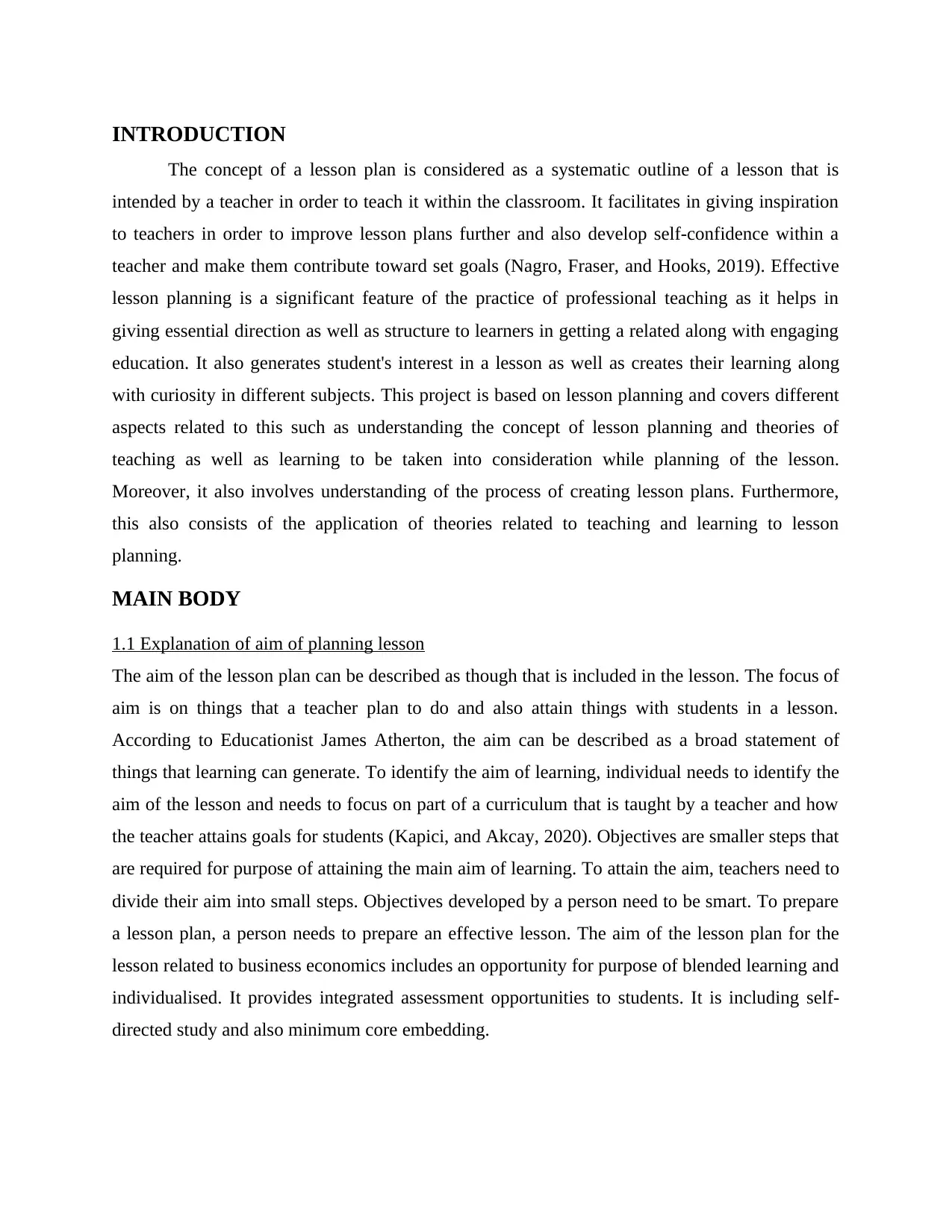
INTRODUCTION
The concept of a lesson plan is considered as a systematic outline of a lesson that is
intended by a teacher in order to teach it within the classroom. It facilitates in giving inspiration
to teachers in order to improve lesson plans further and also develop self-confidence within a
teacher and make them contribute toward set goals (Nagro, Fraser, and Hooks, 2019). Effective
lesson planning is a significant feature of the practice of professional teaching as it helps in
giving essential direction as well as structure to learners in getting a related along with engaging
education. It also generates student's interest in a lesson as well as creates their learning along
with curiosity in different subjects. This project is based on lesson planning and covers different
aspects related to this such as understanding the concept of lesson planning and theories of
teaching as well as learning to be taken into consideration while planning of the lesson.
Moreover, it also involves understanding of the process of creating lesson plans. Furthermore,
this also consists of the application of theories related to teaching and learning to lesson
planning.
MAIN BODY
1.1 Explanation of aim of planning lesson
The aim of the lesson plan can be described as though that is included in the lesson. The focus of
aim is on things that a teacher plan to do and also attain things with students in a lesson.
According to Educationist James Atherton, the aim can be described as a broad statement of
things that learning can generate. To identify the aim of learning, individual needs to identify the
aim of the lesson and needs to focus on part of a curriculum that is taught by a teacher and how
the teacher attains goals for students (Kapici, and Akcay, 2020). Objectives are smaller steps that
are required for purpose of attaining the main aim of learning. To attain the aim, teachers need to
divide their aim into small steps. Objectives developed by a person need to be smart. To prepare
a lesson plan, a person needs to prepare an effective lesson. The aim of the lesson plan for the
lesson related to business economics includes an opportunity for purpose of blended learning and
individualised. It provides integrated assessment opportunities to students. It is including self-
directed study and also minimum core embedding.
The concept of a lesson plan is considered as a systematic outline of a lesson that is
intended by a teacher in order to teach it within the classroom. It facilitates in giving inspiration
to teachers in order to improve lesson plans further and also develop self-confidence within a
teacher and make them contribute toward set goals (Nagro, Fraser, and Hooks, 2019). Effective
lesson planning is a significant feature of the practice of professional teaching as it helps in
giving essential direction as well as structure to learners in getting a related along with engaging
education. It also generates student's interest in a lesson as well as creates their learning along
with curiosity in different subjects. This project is based on lesson planning and covers different
aspects related to this such as understanding the concept of lesson planning and theories of
teaching as well as learning to be taken into consideration while planning of the lesson.
Moreover, it also involves understanding of the process of creating lesson plans. Furthermore,
this also consists of the application of theories related to teaching and learning to lesson
planning.
MAIN BODY
1.1 Explanation of aim of planning lesson
The aim of the lesson plan can be described as though that is included in the lesson. The focus of
aim is on things that a teacher plan to do and also attain things with students in a lesson.
According to Educationist James Atherton, the aim can be described as a broad statement of
things that learning can generate. To identify the aim of learning, individual needs to identify the
aim of the lesson and needs to focus on part of a curriculum that is taught by a teacher and how
the teacher attains goals for students (Kapici, and Akcay, 2020). Objectives are smaller steps that
are required for purpose of attaining the main aim of learning. To attain the aim, teachers need to
divide their aim into small steps. Objectives developed by a person need to be smart. To prepare
a lesson plan, a person needs to prepare an effective lesson. The aim of the lesson plan for the
lesson related to business economics includes an opportunity for purpose of blended learning and
individualised. It provides integrated assessment opportunities to students. It is including self-
directed study and also minimum core embedding.
Paraphrase This Document
Need a fresh take? Get an instant paraphrase of this document with our AI Paraphraser
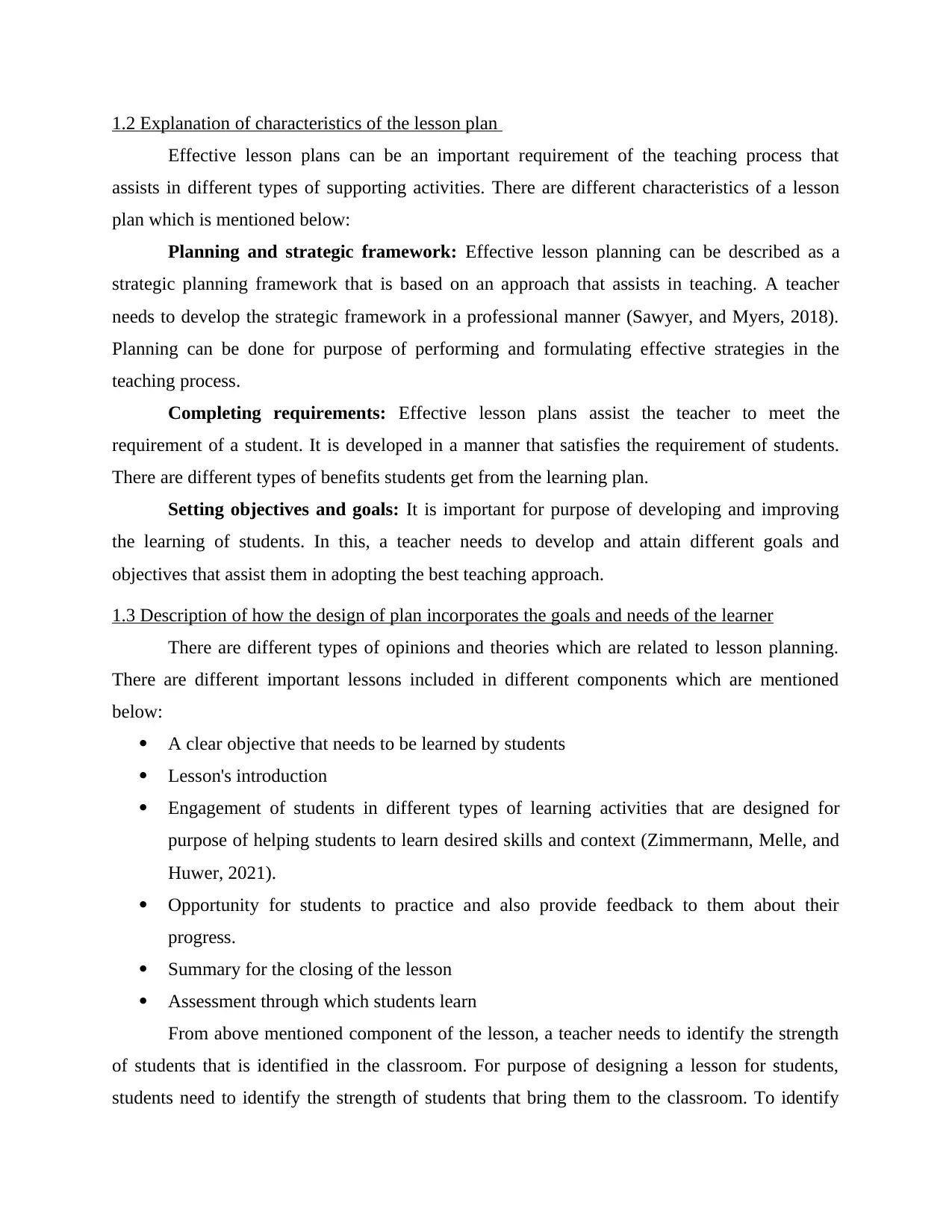
1.2 Explanation of characteristics of the lesson plan
Effective lesson plans can be an important requirement of the teaching process that
assists in different types of supporting activities. There are different characteristics of a lesson
plan which is mentioned below:
Planning and strategic framework: Effective lesson planning can be described as a
strategic planning framework that is based on an approach that assists in teaching. A teacher
needs to develop the strategic framework in a professional manner (Sawyer, and Myers, 2018).
Planning can be done for purpose of performing and formulating effective strategies in the
teaching process.
Completing requirements: Effective lesson plans assist the teacher to meet the
requirement of a student. It is developed in a manner that satisfies the requirement of students.
There are different types of benefits students get from the learning plan.
Setting objectives and goals: It is important for purpose of developing and improving
the learning of students. In this, a teacher needs to develop and attain different goals and
objectives that assist them in adopting the best teaching approach.
1.3 Description of how the design of plan incorporates the goals and needs of the learner
There are different types of opinions and theories which are related to lesson planning.
There are different important lessons included in different components which are mentioned
below:
A clear objective that needs to be learned by students
Lesson's introduction
Engagement of students in different types of learning activities that are designed for
purpose of helping students to learn desired skills and context (Zimmermann, Melle, and
Huwer, 2021).
Opportunity for students to practice and also provide feedback to them about their
progress.
Summary for the closing of the lesson
Assessment through which students learn
From above mentioned component of the lesson, a teacher needs to identify the strength
of students that is identified in the classroom. For purpose of designing a lesson for students,
students need to identify the strength of students that bring them to the classroom. To identify
Effective lesson plans can be an important requirement of the teaching process that
assists in different types of supporting activities. There are different characteristics of a lesson
plan which is mentioned below:
Planning and strategic framework: Effective lesson planning can be described as a
strategic planning framework that is based on an approach that assists in teaching. A teacher
needs to develop the strategic framework in a professional manner (Sawyer, and Myers, 2018).
Planning can be done for purpose of performing and formulating effective strategies in the
teaching process.
Completing requirements: Effective lesson plans assist the teacher to meet the
requirement of a student. It is developed in a manner that satisfies the requirement of students.
There are different types of benefits students get from the learning plan.
Setting objectives and goals: It is important for purpose of developing and improving
the learning of students. In this, a teacher needs to develop and attain different goals and
objectives that assist them in adopting the best teaching approach.
1.3 Description of how the design of plan incorporates the goals and needs of the learner
There are different types of opinions and theories which are related to lesson planning.
There are different important lessons included in different components which are mentioned
below:
A clear objective that needs to be learned by students
Lesson's introduction
Engagement of students in different types of learning activities that are designed for
purpose of helping students to learn desired skills and context (Zimmermann, Melle, and
Huwer, 2021).
Opportunity for students to practice and also provide feedback to them about their
progress.
Summary for the closing of the lesson
Assessment through which students learn
From above mentioned component of the lesson, a teacher needs to identify the strength
of students that is identified in the classroom. For purpose of designing a lesson for students,
students need to identify the strength of students that bring them to the classroom. To identify
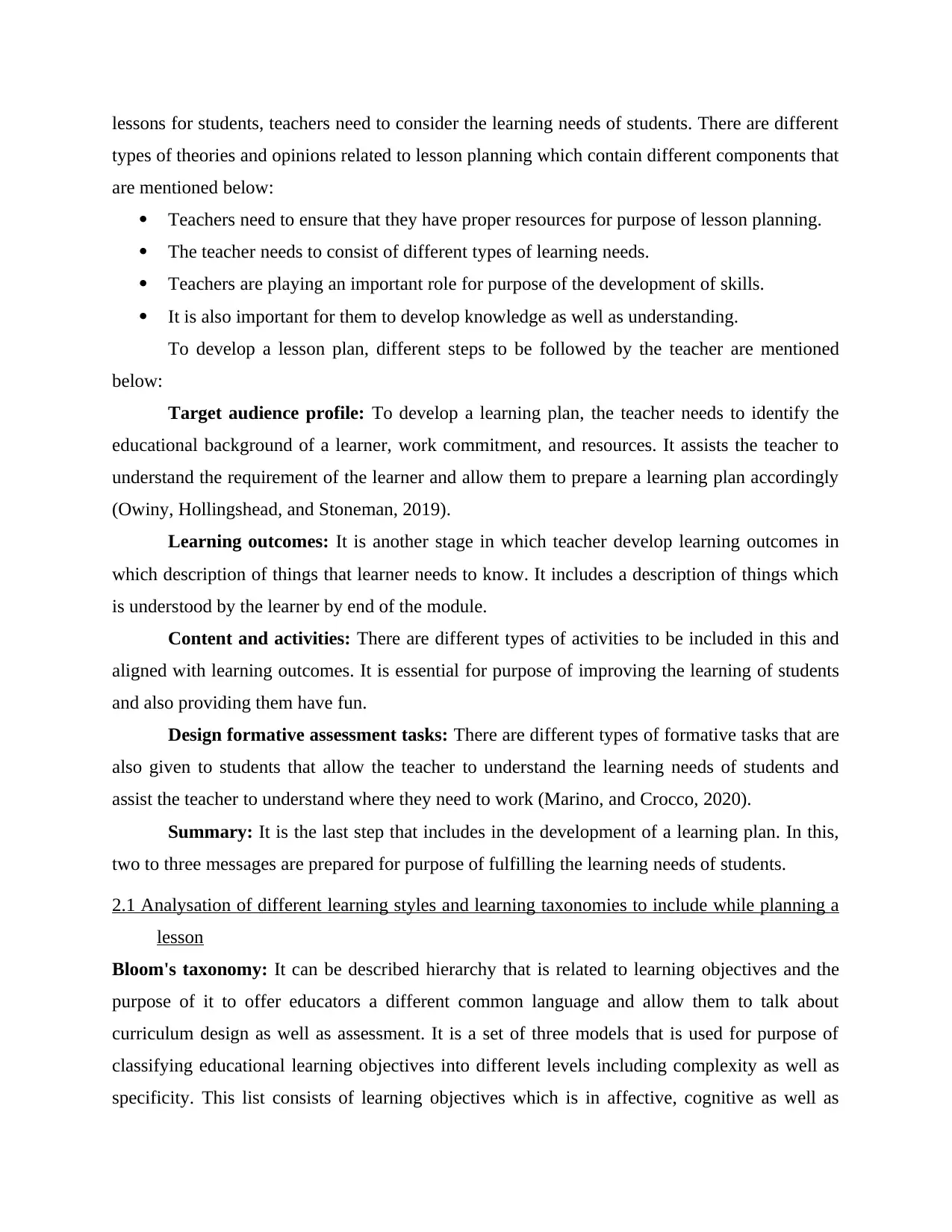
lessons for students, teachers need to consider the learning needs of students. There are different
types of theories and opinions related to lesson planning which contain different components that
are mentioned below:
Teachers need to ensure that they have proper resources for purpose of lesson planning.
The teacher needs to consist of different types of learning needs.
Teachers are playing an important role for purpose of the development of skills.
It is also important for them to develop knowledge as well as understanding.
To develop a lesson plan, different steps to be followed by the teacher are mentioned
below:
Target audience profile: To develop a learning plan, the teacher needs to identify the
educational background of a learner, work commitment, and resources. It assists the teacher to
understand the requirement of the learner and allow them to prepare a learning plan accordingly
(Owiny, Hollingshead, and Stoneman, 2019).
Learning outcomes: It is another stage in which teacher develop learning outcomes in
which description of things that learner needs to know. It includes a description of things which
is understood by the learner by end of the module.
Content and activities: There are different types of activities to be included in this and
aligned with learning outcomes. It is essential for purpose of improving the learning of students
and also providing them have fun.
Design formative assessment tasks: There are different types of formative tasks that are
also given to students that allow the teacher to understand the learning needs of students and
assist the teacher to understand where they need to work (Marino, and Crocco, 2020).
Summary: It is the last step that includes in the development of a learning plan. In this,
two to three messages are prepared for purpose of fulfilling the learning needs of students.
2.1 Analysation of different learning styles and learning taxonomies to include while planning a
lesson
Bloom's taxonomy: It can be described hierarchy that is related to learning objectives and the
purpose of it to offer educators a different common language and allow them to talk about
curriculum design as well as assessment. It is a set of three models that is used for purpose of
classifying educational learning objectives into different levels including complexity as well as
specificity. This list consists of learning objectives which is in affective, cognitive as well as
types of theories and opinions related to lesson planning which contain different components that
are mentioned below:
Teachers need to ensure that they have proper resources for purpose of lesson planning.
The teacher needs to consist of different types of learning needs.
Teachers are playing an important role for purpose of the development of skills.
It is also important for them to develop knowledge as well as understanding.
To develop a lesson plan, different steps to be followed by the teacher are mentioned
below:
Target audience profile: To develop a learning plan, the teacher needs to identify the
educational background of a learner, work commitment, and resources. It assists the teacher to
understand the requirement of the learner and allow them to prepare a learning plan accordingly
(Owiny, Hollingshead, and Stoneman, 2019).
Learning outcomes: It is another stage in which teacher develop learning outcomes in
which description of things that learner needs to know. It includes a description of things which
is understood by the learner by end of the module.
Content and activities: There are different types of activities to be included in this and
aligned with learning outcomes. It is essential for purpose of improving the learning of students
and also providing them have fun.
Design formative assessment tasks: There are different types of formative tasks that are
also given to students that allow the teacher to understand the learning needs of students and
assist the teacher to understand where they need to work (Marino, and Crocco, 2020).
Summary: It is the last step that includes in the development of a learning plan. In this,
two to three messages are prepared for purpose of fulfilling the learning needs of students.
2.1 Analysation of different learning styles and learning taxonomies to include while planning a
lesson
Bloom's taxonomy: It can be described hierarchy that is related to learning objectives and the
purpose of it to offer educators a different common language and allow them to talk about
curriculum design as well as assessment. It is a set of three models that is used for purpose of
classifying educational learning objectives into different levels including complexity as well as
specificity. This list consists of learning objectives which is in affective, cognitive as well as
⊘ This is a preview!⊘
Do you want full access?
Subscribe today to unlock all pages.

Trusted by 1+ million students worldwide
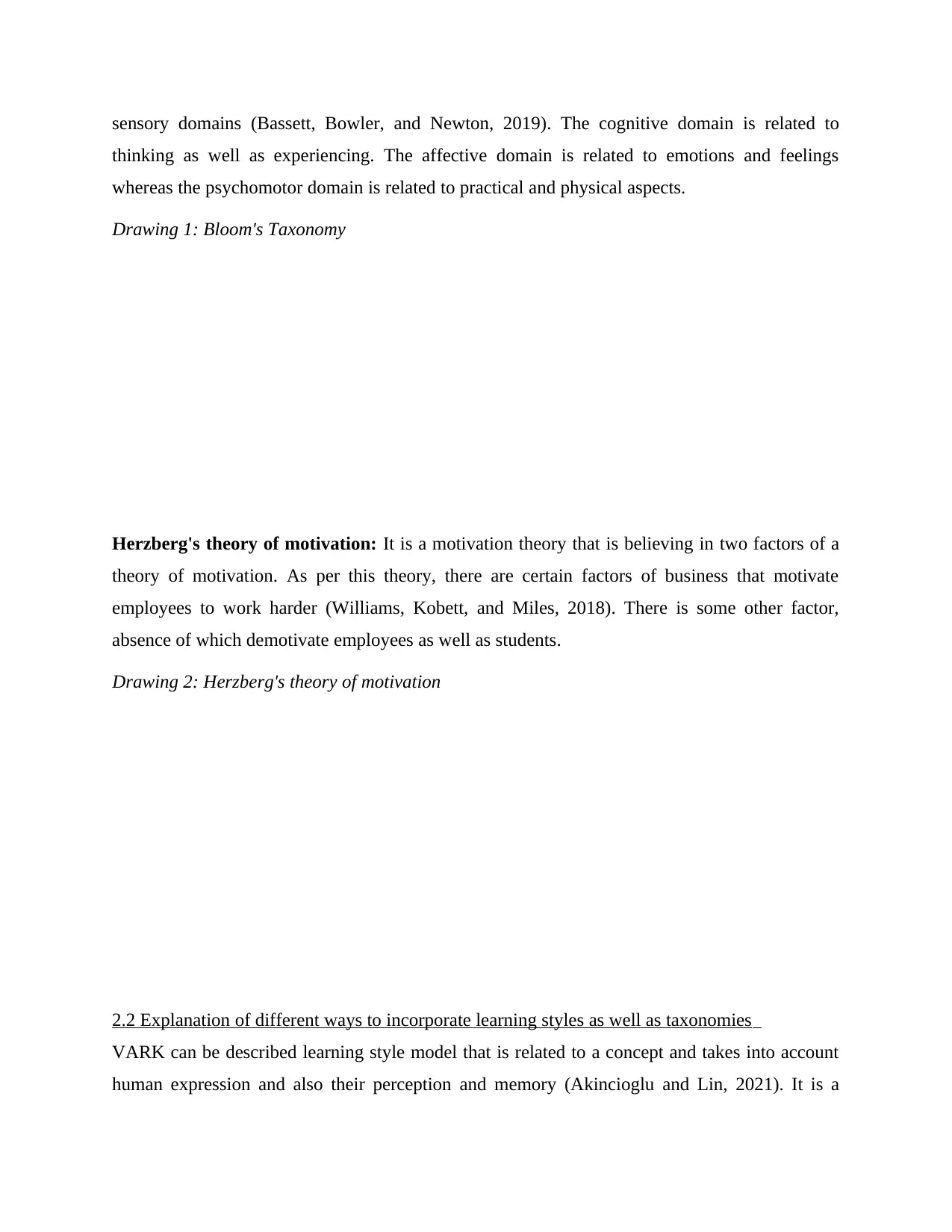
sensory domains (Bassett, Bowler, and Newton, 2019). The cognitive domain is related to
thinking as well as experiencing. The affective domain is related to emotions and feelings
whereas the psychomotor domain is related to practical and physical aspects.
Drawing 1: Bloom's Taxonomy
Herzberg's theory of motivation: It is a motivation theory that is believing in two factors of a
theory of motivation. As per this theory, there are certain factors of business that motivate
employees to work harder (Williams, Kobett, and Miles, 2018). There is some other factor,
absence of which demotivate employees as well as students.
Drawing 2: Herzberg's theory of motivation
2.2 Explanation of different ways to incorporate learning styles as well as taxonomies
VARK can be described learning style model that is related to a concept and takes into account
human expression and also their perception and memory (Akincioglu and Lin, 2021). It is a
thinking as well as experiencing. The affective domain is related to emotions and feelings
whereas the psychomotor domain is related to practical and physical aspects.
Drawing 1: Bloom's Taxonomy
Herzberg's theory of motivation: It is a motivation theory that is believing in two factors of a
theory of motivation. As per this theory, there are certain factors of business that motivate
employees to work harder (Williams, Kobett, and Miles, 2018). There is some other factor,
absence of which demotivate employees as well as students.
Drawing 2: Herzberg's theory of motivation
2.2 Explanation of different ways to incorporate learning styles as well as taxonomies
VARK can be described learning style model that is related to a concept and takes into account
human expression and also their perception and memory (Akincioglu and Lin, 2021). It is a
Paraphrase This Document
Need a fresh take? Get an instant paraphrase of this document with our AI Paraphraser
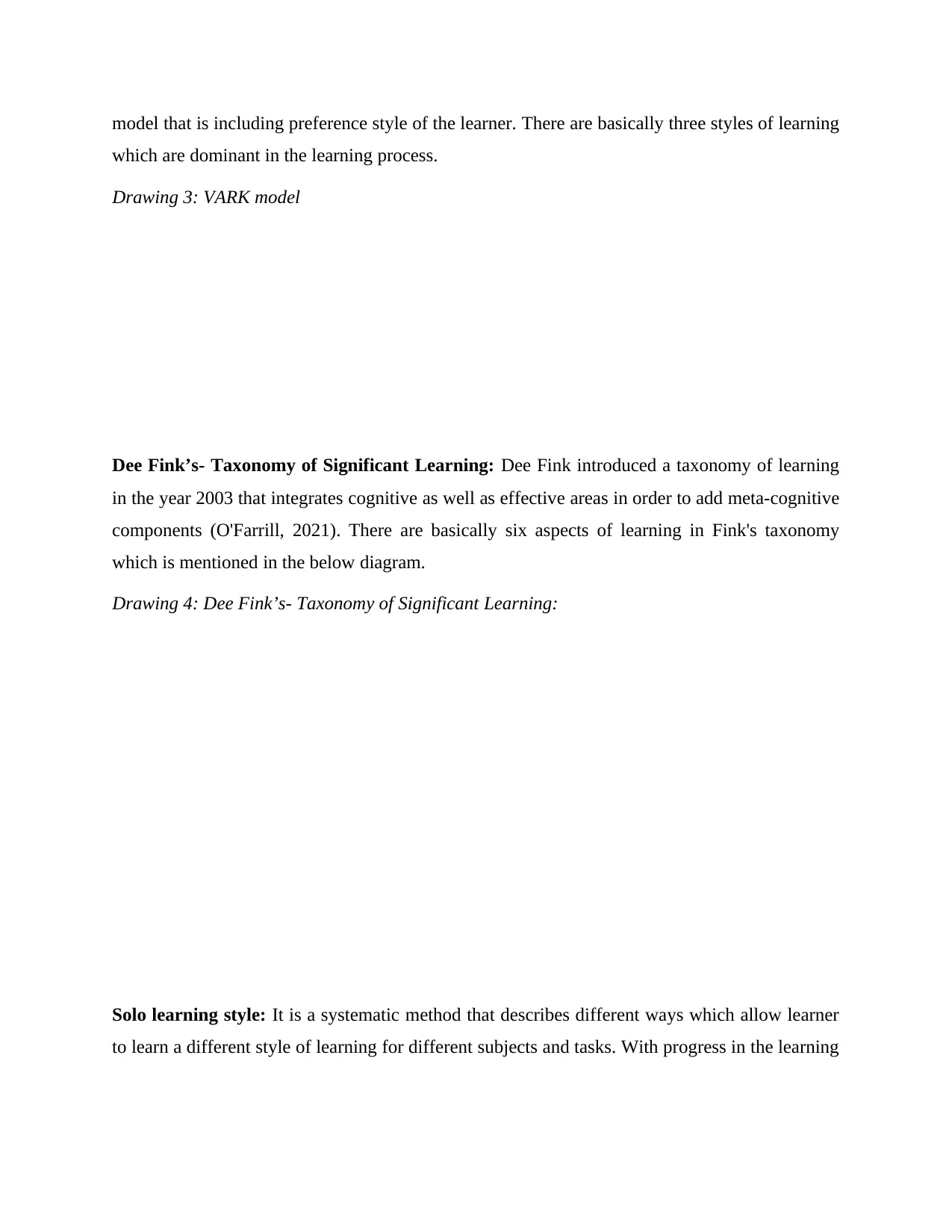
model that is including preference style of the learner. There are basically three styles of learning
which are dominant in the learning process.
Drawing 3: VARK model
Dee Fink’s- Taxonomy of Significant Learning: Dee Fink introduced a taxonomy of learning
in the year 2003 that integrates cognitive as well as effective areas in order to add meta-cognitive
components (O'Farrill, 2021). There are basically six aspects of learning in Fink's taxonomy
which is mentioned in the below diagram.
Drawing 4: Dee Fink’s- Taxonomy of Significant Learning:
Solo learning style: It is a systematic method that describes different ways which allow learner
to learn a different style of learning for different subjects and tasks. With progress in the learning
which are dominant in the learning process.
Drawing 3: VARK model
Dee Fink’s- Taxonomy of Significant Learning: Dee Fink introduced a taxonomy of learning
in the year 2003 that integrates cognitive as well as effective areas in order to add meta-cognitive
components (O'Farrill, 2021). There are basically six aspects of learning in Fink's taxonomy
which is mentioned in the below diagram.
Drawing 4: Dee Fink’s- Taxonomy of Significant Learning:
Solo learning style: It is a systematic method that describes different ways which allow learner
to learn a different style of learning for different subjects and tasks. With progress in the learning
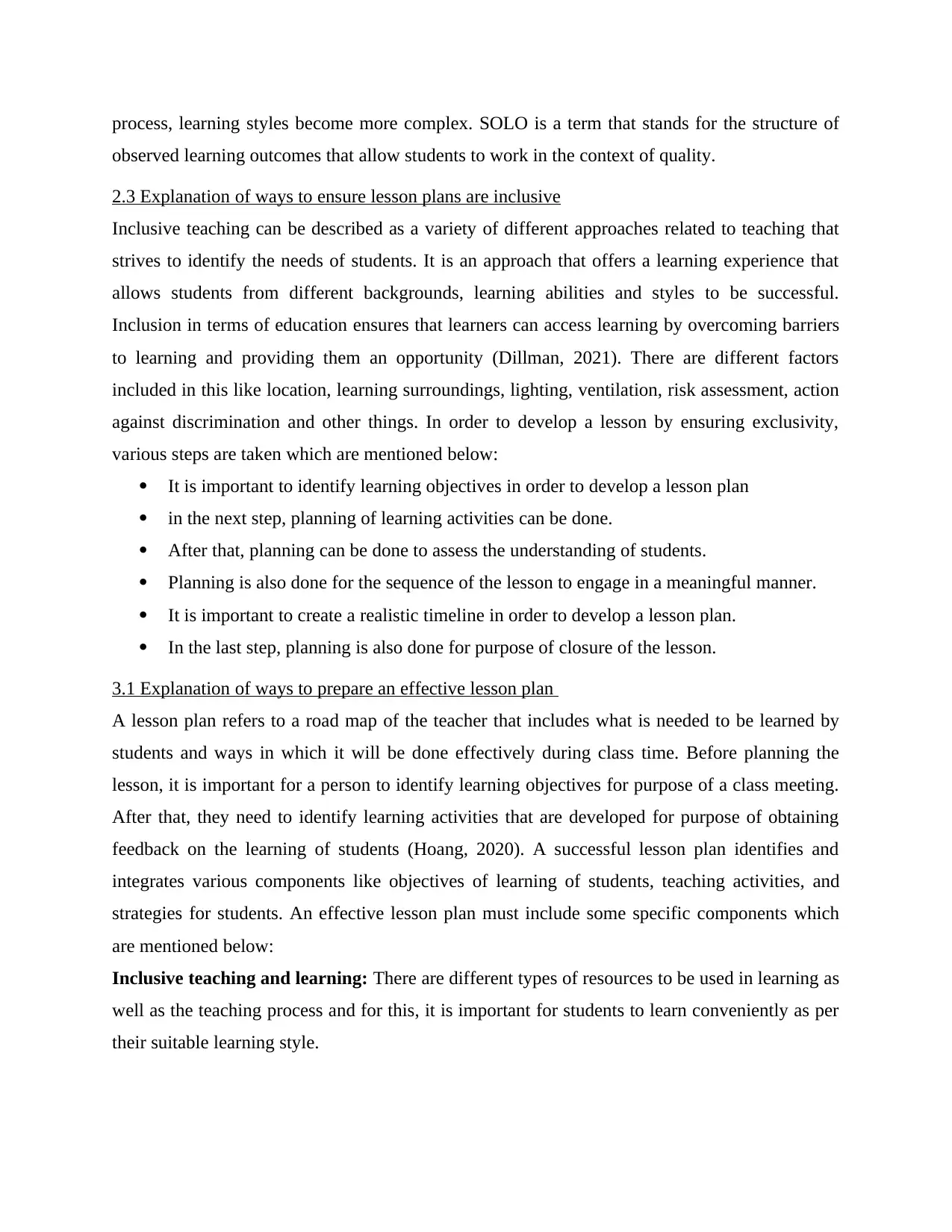
process, learning styles become more complex. SOLO is a term that stands for the structure of
observed learning outcomes that allow students to work in the context of quality.
2.3 Explanation of ways to ensure lesson plans are inclusive
Inclusive teaching can be described as a variety of different approaches related to teaching that
strives to identify the needs of students. It is an approach that offers a learning experience that
allows students from different backgrounds, learning abilities and styles to be successful.
Inclusion in terms of education ensures that learners can access learning by overcoming barriers
to learning and providing them an opportunity (Dillman, 2021). There are different factors
included in this like location, learning surroundings, lighting, ventilation, risk assessment, action
against discrimination and other things. In order to develop a lesson by ensuring exclusivity,
various steps are taken which are mentioned below:
It is important to identify learning objectives in order to develop a lesson plan
in the next step, planning of learning activities can be done.
After that, planning can be done to assess the understanding of students.
Planning is also done for the sequence of the lesson to engage in a meaningful manner.
It is important to create a realistic timeline in order to develop a lesson plan.
In the last step, planning is also done for purpose of closure of the lesson.
3.1 Explanation of ways to prepare an effective lesson plan
A lesson plan refers to a road map of the teacher that includes what is needed to be learned by
students and ways in which it will be done effectively during class time. Before planning the
lesson, it is important for a person to identify learning objectives for purpose of a class meeting.
After that, they need to identify learning activities that are developed for purpose of obtaining
feedback on the learning of students (Hoang, 2020). A successful lesson plan identifies and
integrates various components like objectives of learning of students, teaching activities, and
strategies for students. An effective lesson plan must include some specific components which
are mentioned below:
Inclusive teaching and learning: There are different types of resources to be used in learning as
well as the teaching process and for this, it is important for students to learn conveniently as per
their suitable learning style.
observed learning outcomes that allow students to work in the context of quality.
2.3 Explanation of ways to ensure lesson plans are inclusive
Inclusive teaching can be described as a variety of different approaches related to teaching that
strives to identify the needs of students. It is an approach that offers a learning experience that
allows students from different backgrounds, learning abilities and styles to be successful.
Inclusion in terms of education ensures that learners can access learning by overcoming barriers
to learning and providing them an opportunity (Dillman, 2021). There are different factors
included in this like location, learning surroundings, lighting, ventilation, risk assessment, action
against discrimination and other things. In order to develop a lesson by ensuring exclusivity,
various steps are taken which are mentioned below:
It is important to identify learning objectives in order to develop a lesson plan
in the next step, planning of learning activities can be done.
After that, planning can be done to assess the understanding of students.
Planning is also done for the sequence of the lesson to engage in a meaningful manner.
It is important to create a realistic timeline in order to develop a lesson plan.
In the last step, planning is also done for purpose of closure of the lesson.
3.1 Explanation of ways to prepare an effective lesson plan
A lesson plan refers to a road map of the teacher that includes what is needed to be learned by
students and ways in which it will be done effectively during class time. Before planning the
lesson, it is important for a person to identify learning objectives for purpose of a class meeting.
After that, they need to identify learning activities that are developed for purpose of obtaining
feedback on the learning of students (Hoang, 2020). A successful lesson plan identifies and
integrates various components like objectives of learning of students, teaching activities, and
strategies for students. An effective lesson plan must include some specific components which
are mentioned below:
Inclusive teaching and learning: There are different types of resources to be used in learning as
well as the teaching process and for this, it is important for students to learn conveniently as per
their suitable learning style.
⊘ This is a preview!⊘
Do you want full access?
Subscribe today to unlock all pages.

Trusted by 1+ million students worldwide
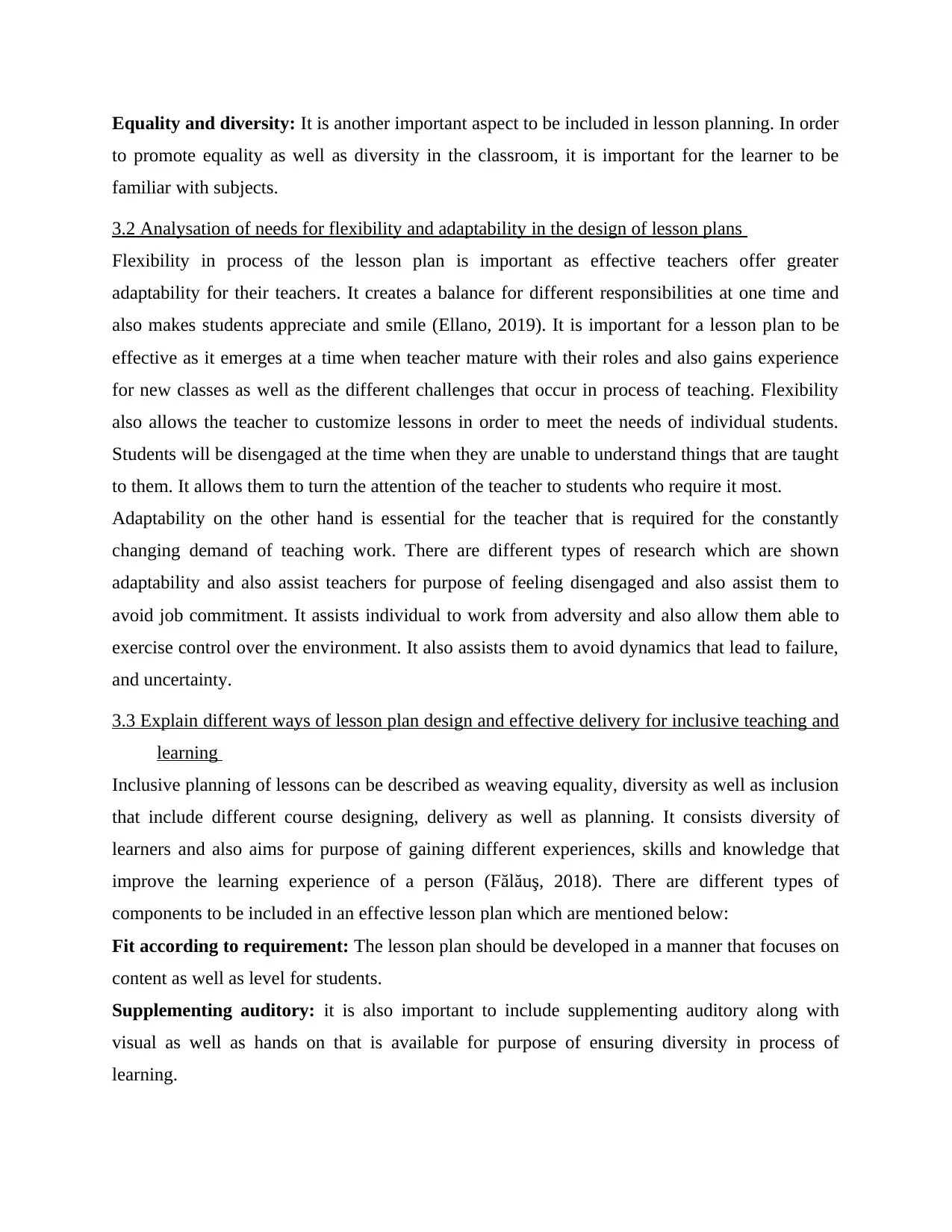
Equality and diversity: It is another important aspect to be included in lesson planning. In order
to promote equality as well as diversity in the classroom, it is important for the learner to be
familiar with subjects.
3.2 Analysation of needs for flexibility and adaptability in the design of lesson plans
Flexibility in process of the lesson plan is important as effective teachers offer greater
adaptability for their teachers. It creates a balance for different responsibilities at one time and
also makes students appreciate and smile (Ellano, 2019). It is important for a lesson plan to be
effective as it emerges at a time when teacher mature with their roles and also gains experience
for new classes as well as the different challenges that occur in process of teaching. Flexibility
also allows the teacher to customize lessons in order to meet the needs of individual students.
Students will be disengaged at the time when they are unable to understand things that are taught
to them. It allows them to turn the attention of the teacher to students who require it most.
Adaptability on the other hand is essential for the teacher that is required for the constantly
changing demand of teaching work. There are different types of research which are shown
adaptability and also assist teachers for purpose of feeling disengaged and also assist them to
avoid job commitment. It assists individual to work from adversity and also allow them able to
exercise control over the environment. It also assists them to avoid dynamics that lead to failure,
and uncertainty.
3.3 Explain different ways of lesson plan design and effective delivery for inclusive teaching and
learning
Inclusive planning of lessons can be described as weaving equality, diversity as well as inclusion
that include different course designing, delivery as well as planning. It consists diversity of
learners and also aims for purpose of gaining different experiences, skills and knowledge that
improve the learning experience of a person (Fălăuş, 2018). There are different types of
components to be included in an effective lesson plan which are mentioned below:
Fit according to requirement: The lesson plan should be developed in a manner that focuses on
content as well as level for students.
Supplementing auditory: it is also important to include supplementing auditory along with
visual as well as hands on that is available for purpose of ensuring diversity in process of
learning.
to promote equality as well as diversity in the classroom, it is important for the learner to be
familiar with subjects.
3.2 Analysation of needs for flexibility and adaptability in the design of lesson plans
Flexibility in process of the lesson plan is important as effective teachers offer greater
adaptability for their teachers. It creates a balance for different responsibilities at one time and
also makes students appreciate and smile (Ellano, 2019). It is important for a lesson plan to be
effective as it emerges at a time when teacher mature with their roles and also gains experience
for new classes as well as the different challenges that occur in process of teaching. Flexibility
also allows the teacher to customize lessons in order to meet the needs of individual students.
Students will be disengaged at the time when they are unable to understand things that are taught
to them. It allows them to turn the attention of the teacher to students who require it most.
Adaptability on the other hand is essential for the teacher that is required for the constantly
changing demand of teaching work. There are different types of research which are shown
adaptability and also assist teachers for purpose of feeling disengaged and also assist them to
avoid job commitment. It assists individual to work from adversity and also allow them able to
exercise control over the environment. It also assists them to avoid dynamics that lead to failure,
and uncertainty.
3.3 Explain different ways of lesson plan design and effective delivery for inclusive teaching and
learning
Inclusive planning of lessons can be described as weaving equality, diversity as well as inclusion
that include different course designing, delivery as well as planning. It consists diversity of
learners and also aims for purpose of gaining different experiences, skills and knowledge that
improve the learning experience of a person (Fălăuş, 2018). There are different types of
components to be included in an effective lesson plan which are mentioned below:
Fit according to requirement: The lesson plan should be developed in a manner that focuses on
content as well as level for students.
Supplementing auditory: it is also important to include supplementing auditory along with
visual as well as hands on that is available for purpose of ensuring diversity in process of
learning.
Paraphrase This Document
Need a fresh take? Get an instant paraphrase of this document with our AI Paraphraser
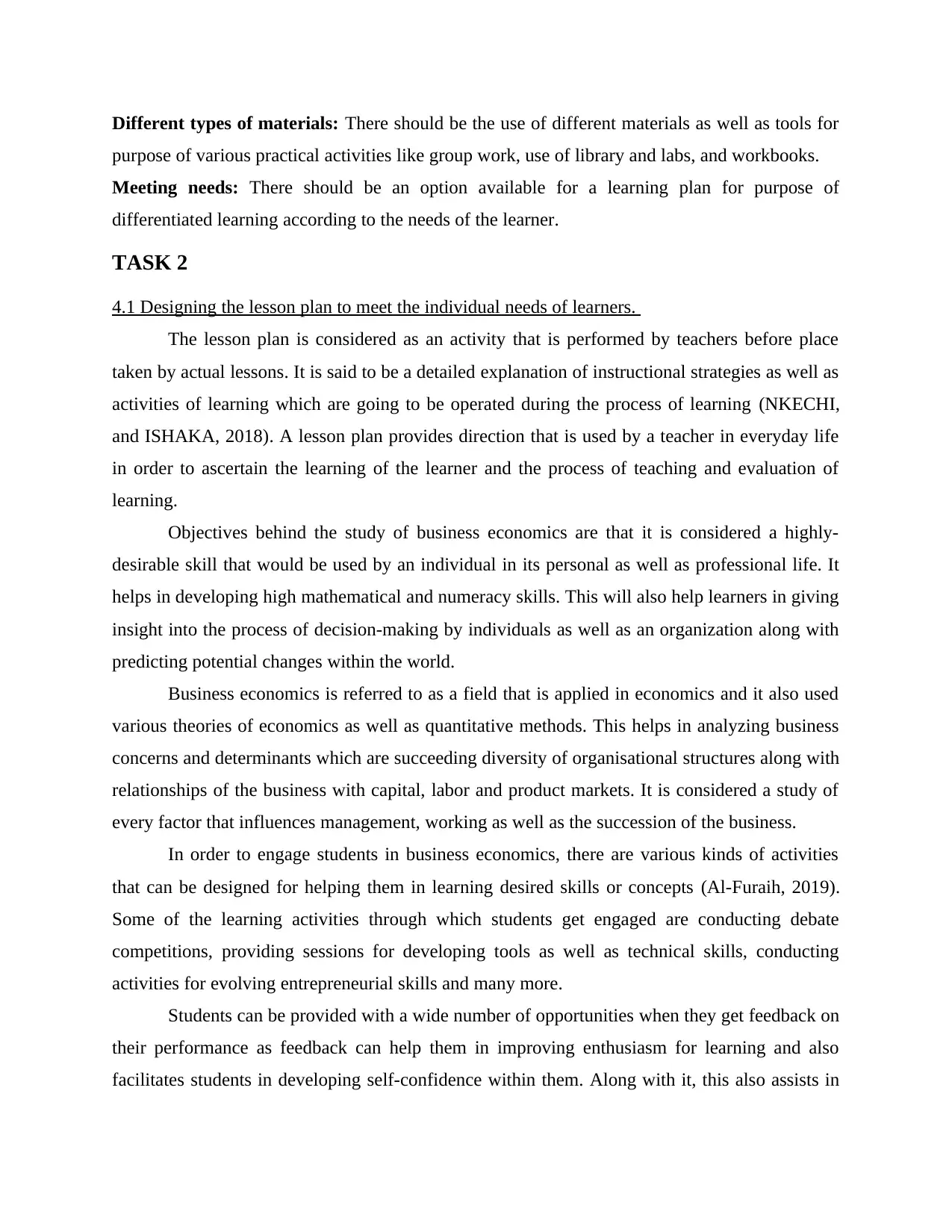
Different types of materials: There should be the use of different materials as well as tools for
purpose of various practical activities like group work, use of library and labs, and workbooks.
Meeting needs: There should be an option available for a learning plan for purpose of
differentiated learning according to the needs of the learner.
TASK 2
4.1 Designing the lesson plan to meet the individual needs of learners.
The lesson plan is considered as an activity that is performed by teachers before place
taken by actual lessons. It is said to be a detailed explanation of instructional strategies as well as
activities of learning which are going to be operated during the process of learning (NKECHI,
and ISHAKA, 2018). A lesson plan provides direction that is used by a teacher in everyday life
in order to ascertain the learning of the learner and the process of teaching and evaluation of
learning.
Objectives behind the study of business economics are that it is considered a highly-
desirable skill that would be used by an individual in its personal as well as professional life. It
helps in developing high mathematical and numeracy skills. This will also help learners in giving
insight into the process of decision-making by individuals as well as an organization along with
predicting potential changes within the world.
Business economics is referred to as a field that is applied in economics and it also used
various theories of economics as well as quantitative methods. This helps in analyzing business
concerns and determinants which are succeeding diversity of organisational structures along with
relationships of the business with capital, labor and product markets. It is considered a study of
every factor that influences management, working as well as the succession of the business.
In order to engage students in business economics, there are various kinds of activities
that can be designed for helping them in learning desired skills or concepts (Al-Furaih, 2019).
Some of the learning activities through which students get engaged are conducting debate
competitions, providing sessions for developing tools as well as technical skills, conducting
activities for evolving entrepreneurial skills and many more.
Students can be provided with a wide number of opportunities when they get feedback on
their performance as feedback can help them in improving enthusiasm for learning and also
facilitates students in developing self-confidence within them. Along with it, this also assists in
purpose of various practical activities like group work, use of library and labs, and workbooks.
Meeting needs: There should be an option available for a learning plan for purpose of
differentiated learning according to the needs of the learner.
TASK 2
4.1 Designing the lesson plan to meet the individual needs of learners.
The lesson plan is considered as an activity that is performed by teachers before place
taken by actual lessons. It is said to be a detailed explanation of instructional strategies as well as
activities of learning which are going to be operated during the process of learning (NKECHI,
and ISHAKA, 2018). A lesson plan provides direction that is used by a teacher in everyday life
in order to ascertain the learning of the learner and the process of teaching and evaluation of
learning.
Objectives behind the study of business economics are that it is considered a highly-
desirable skill that would be used by an individual in its personal as well as professional life. It
helps in developing high mathematical and numeracy skills. This will also help learners in giving
insight into the process of decision-making by individuals as well as an organization along with
predicting potential changes within the world.
Business economics is referred to as a field that is applied in economics and it also used
various theories of economics as well as quantitative methods. This helps in analyzing business
concerns and determinants which are succeeding diversity of organisational structures along with
relationships of the business with capital, labor and product markets. It is considered a study of
every factor that influences management, working as well as the succession of the business.
In order to engage students in business economics, there are various kinds of activities
that can be designed for helping them in learning desired skills or concepts (Al-Furaih, 2019).
Some of the learning activities through which students get engaged are conducting debate
competitions, providing sessions for developing tools as well as technical skills, conducting
activities for evolving entrepreneurial skills and many more.
Students can be provided with a wide number of opportunities when they get feedback on
their performance as feedback can help them in improving enthusiasm for learning and also
facilitates students in developing self-confidence within them. Along with it, this also assists in
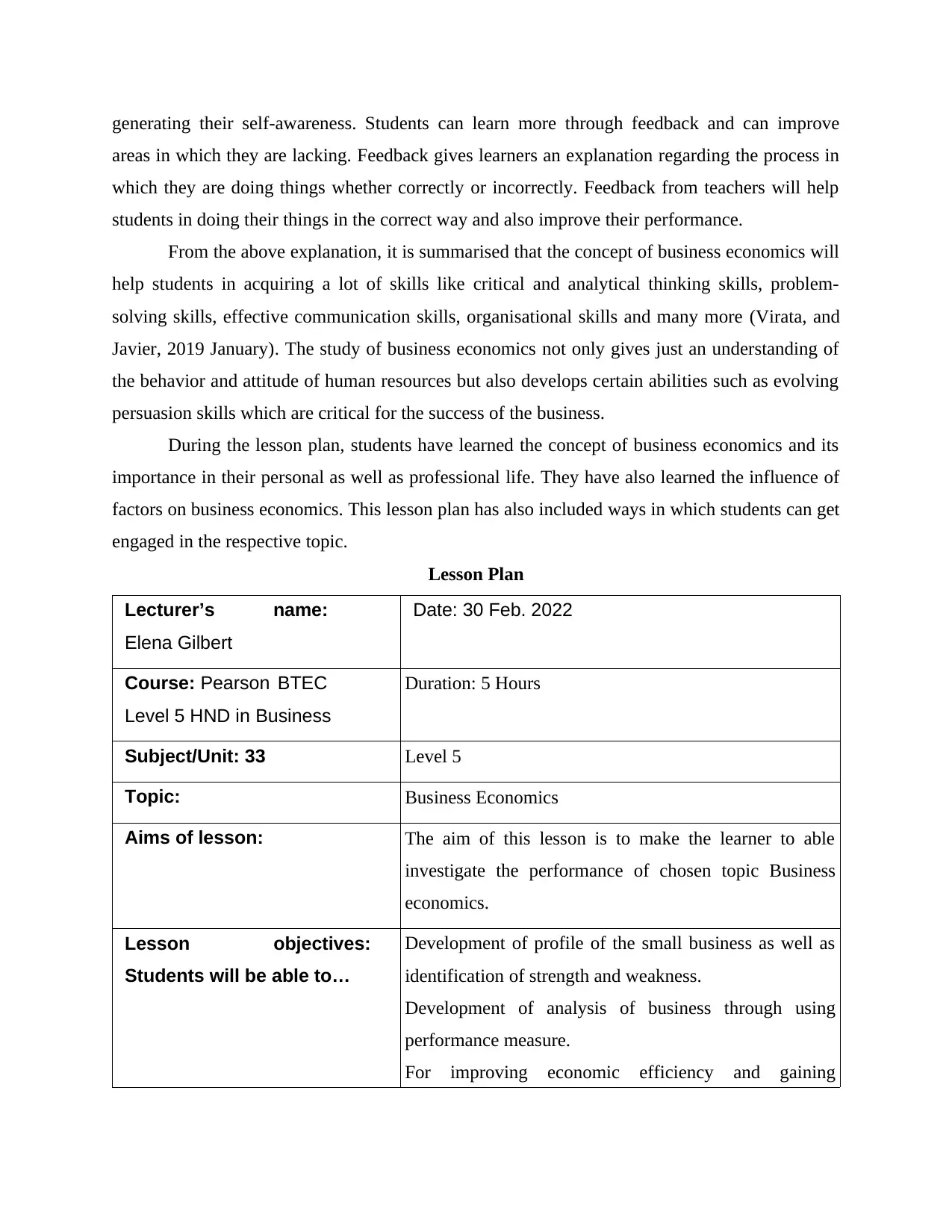
generating their self-awareness. Students can learn more through feedback and can improve
areas in which they are lacking. Feedback gives learners an explanation regarding the process in
which they are doing things whether correctly or incorrectly. Feedback from teachers will help
students in doing their things in the correct way and also improve their performance.
From the above explanation, it is summarised that the concept of business economics will
help students in acquiring a lot of skills like critical and analytical thinking skills, problem-
solving skills, effective communication skills, organisational skills and many more (Virata, and
Javier, 2019 January). The study of business economics not only gives just an understanding of
the behavior and attitude of human resources but also develops certain abilities such as evolving
persuasion skills which are critical for the success of the business.
During the lesson plan, students have learned the concept of business economics and its
importance in their personal as well as professional life. They have also learned the influence of
factors on business economics. This lesson plan has also included ways in which students can get
engaged in the respective topic.
Lesson Plan
Lecturer’s name:
Elena Gilbert
Date: 30 Feb. 2022
Course: Pearson BTEC
Level 5 HND in Business
Duration: 5 Hours
Subject/Unit: 33 Level 5
Topic: Business Economics
Aims of lesson: The aim of this lesson is to make the learner to able
investigate the performance of chosen topic Business
economics.
Lesson objectives:
Students will be able to…
Development of profile of the small business as well as
identification of strength and weakness.
Development of analysis of business through using
performance measure.
For improving economic efficiency and gaining
areas in which they are lacking. Feedback gives learners an explanation regarding the process in
which they are doing things whether correctly or incorrectly. Feedback from teachers will help
students in doing their things in the correct way and also improve their performance.
From the above explanation, it is summarised that the concept of business economics will
help students in acquiring a lot of skills like critical and analytical thinking skills, problem-
solving skills, effective communication skills, organisational skills and many more (Virata, and
Javier, 2019 January). The study of business economics not only gives just an understanding of
the behavior and attitude of human resources but also develops certain abilities such as evolving
persuasion skills which are critical for the success of the business.
During the lesson plan, students have learned the concept of business economics and its
importance in their personal as well as professional life. They have also learned the influence of
factors on business economics. This lesson plan has also included ways in which students can get
engaged in the respective topic.
Lesson Plan
Lecturer’s name:
Elena Gilbert
Date: 30 Feb. 2022
Course: Pearson BTEC
Level 5 HND in Business
Duration: 5 Hours
Subject/Unit: 33 Level 5
Topic: Business Economics
Aims of lesson: The aim of this lesson is to make the learner to able
investigate the performance of chosen topic Business
economics.
Lesson objectives:
Students will be able to…
Development of profile of the small business as well as
identification of strength and weakness.
Development of analysis of business through using
performance measure.
For improving economic efficiency and gaining
⊘ This is a preview!⊘
Do you want full access?
Subscribe today to unlock all pages.

Trusted by 1+ million students worldwide
1 out of 24
Related Documents
Your All-in-One AI-Powered Toolkit for Academic Success.
+13062052269
info@desklib.com
Available 24*7 on WhatsApp / Email
![[object Object]](/_next/static/media/star-bottom.7253800d.svg)
Unlock your academic potential
Copyright © 2020–2025 A2Z Services. All Rights Reserved. Developed and managed by ZUCOL.




